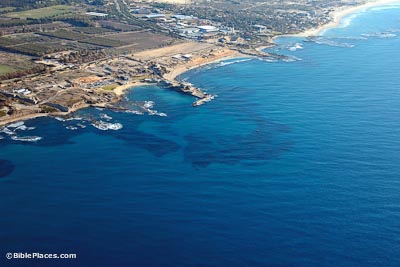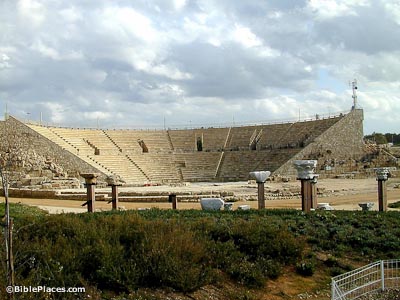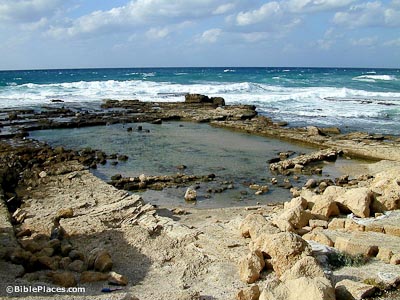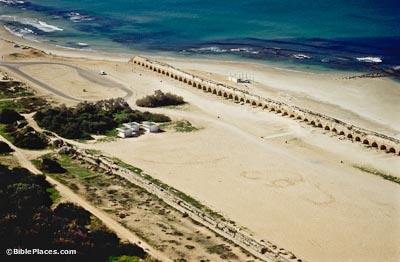This site was insignificant until Herod the Great began to develop it into a magnificent harbor befitting his kingdom. The harbor was built using materials that would allow the concrete to harden underwater. The 40-acre (16-ha) harbor would accommodate 300 ships, much larger than the modern harbor existing today.
Caesarea Maritima
The Theater
Herod the Great also constructed a theater with a seating capacity of 3,500. According to Josephus, this is where the death of Herod Agrippa occurred, as recounted in Acts 12. The theater was covered with a skin covering (vellum), and visitors probably brought cushions with them to soften the stone seats.
Promontory Palace
Josephus called this a “most magnificent palace” that Herod the Great built on a promontory jutting out into the waters of Caesarea. The pool in the center was nearly Olympic in size, and was filled with fresh water. A statue once stood in the center. Paul may have been imprisoned on the grounds of this palace (Acts 23:35).
The Aqueduct
The lack of fresh water at Herod’s new city required a lengthy aqueduct to bring water from springs at the base of Mount Carmel nearly 10 miles (16 km) away. To ensure that the water would flow by the pull of gravity, the aqueduct was built on arches and the gradient was carefully measured. Later, Hadrian and the Crusaders would attach additional channels to Herod’s aqueduct.

Download all of our Samaria and the Center photos!
$39.00 $49.99 FREE SHIPPING
Related Websites
Find historical images of Caesarea and illustrations related to Peter and Cornelius at Life in the Holy Land. See also our pages on Acts.
Caesarea (Jewish Virtual Library) Contains sections highlighting the Roman, Byzantine, Arab, and Crusader periods in the history of the site. Includes several pictures alongside relevant text.
OnSite: Caesarea Maritima (Bible History Daily) A “virtual tour” featuring a six-minute video and several photos.
Caesarea Maritima (Cornell Institute of Archaeology) A brief overview, discussing Cornell’s excavations there, and some of the history as narrated by the Bible and Josephus.
Paul in Caesarea (The Bible Journey) A good look at the verses that mention Paul’s time in the city.
Rare Greek Inscription and Colorful 1,800-Year Old Mosaic Uncovered at Caesarea (Times of Israel) This 2018 article discusses this remarkable find, including photos.
Rare Gold Coins Found in Israeli City of Caesarea (BBC News) An article on the discovery of Crusader gold in Caesarea.
New Discoveries Unveiled at Caesarea Maritima (Biblical Archaeology Society) A 2017 article discussing discoveries including a “mother-of-pearl tablet inscribed with a seven-branched menorah.”
Caesarea (Virtual Israel Experience) An extension of the Jewish Virtual Library, this user-friendly page gives a readable account of the history of the site, along with a summary of the important archaeological finds, and modern features of the area.
Caesarea Maritima (Into His Own) A brief, encyclopedia-type article with multiple links to related topics for further study.
Caesarea Maritima Mithraeum (Atlas Obscura) A discussion of the mithraeum, some of the surrounding mythology, and historical connections. Also includes some excellent photos.
Caesarea (Crystalinks) Reviews the historical and archaeological importance of this site with unique attention to interesting historical details.
Caesarea, Archaeology in Israel (Jewish Magazine) Provides the historical background of the city and its aqueduct, theatre, city walls, and harbor.
Caesarea (personal page) Limited text but features several unique pictures from 1992.
Seldom Visited Aqueduct at Caesarea (Holy Land Photos, Carl Rasmussen) A few photos (and a link to more) relating to part of the Herodian aqueduct that lies north of the main site; includes directions on how to get there.
Divers Discover Sunken Cargo at Herod’s Port City (Bible History Daily) An enjoyable article about a Late Roman cargo ship sunk in the harbor…and then re-discovered.
Caesarea Underwater Archaeological Park (Israel and You) Everything you need to know to go scuba diving among the remarkable underwater ruins.
Constructing the Harbour of Caesarea on the Sea (originally published in The International Journal of Nautical Archaeology) Highlights on this site include a strikingly clear aerial photo, a reconstruction of how the harbor was constructed, and some technical information.
Sebastos: Herod’s Harbor at Caesarea Maritime (ResearchGate.net) Scroll down far enough, and you can read all of this 1983 article illustrated with black and white photos and sketched plans; packed with information.
Mystery of Caesarea’s Disappearing Port (Segula) A detailed article exploring the history of the harbor, including an explanation for why it looks like it does today.



